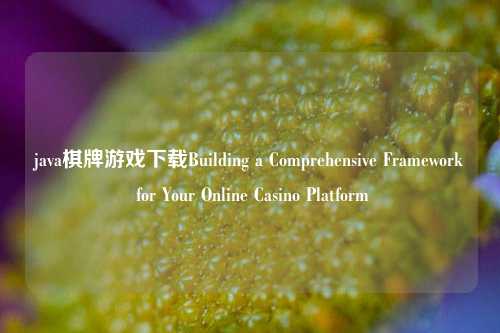In the ever-evolving world of online gaming and casinos, developing a robust game engine that supports multiple games, high performance, and seamless integration with various payment gateways is crucial. One such framework that can handle these requirements efficiently isJava, a versatile programming language used extensively in the development of web applications, mobile apps, and desktop software.
This article will explore how to leverage Java to build an effective game development platform suitable for an online casino. We'll delve into key components like game architecture design, server-side setup, client-server communication, user authentication, and payment processing. Additionally, we'll cover essential tools and libraries needed for this endeavor.

1. Setting Up Your Java Environment
Before diving into game development, ensure you have the necessary environment set up on your computer. Here's what you need:
Java Development Kit (JDK): Download and install JDK from the official Oracle website or AdoptOpenJDK.
IDE: Choose an Integrated Development Environment (IDE) like IntelliJ IDEA, Eclipse, or NetBeans. These tools provide features such as code completion, debugging, and project management.
Once installed, create a new Java project in your IDE using your preferred SDK.
2. Designing Your Game Architecture
A well-designed architecture ensures scalability, maintainability, and efficient resource utilization. For an online casino game, consider the following architectural elements:
Microservices Approach: Split your application into smaller, independent services each responsible for handling specific functionalities. This makes it easier to manage different aspects of the system without affecting others.
Event-driven Architecture: Implement event-driven patterns where actions trigger other events which in turn lead to further processes. This helps decouple different parts of the application and improves responsiveness.
RESTful Services: Use REST APIs for communication between microservices. RESTful design principles simplify service interactions while ensuring compatibility across various environments.
Server-Side Setup
To support multiplayer games and real-time updates, a server-side solution is essential. Consider deploying a Java-based backend on cloud platforms such as AWS, Azure, or Google Cloud. Below are some steps to get started:
Setting Up a Java Web Application: Create a Spring Boot project using Maven or Gradle. Configure the application to use JPA repositories for database operations.
Database Integration: Integrate your game data into a relational database management system (RDBMS). Hibernate, an ORM tool for Java, simplifies database interactions.
Session Management: Utilize technologies like Redis for session state management to enhance performance and security.
4. Client-Server Communication
Establishing a reliable communication channel between the client and server is critical. WebSocket provides bi-directional message passing between clients and servers, making it ideal for real-time games. Here’s how you can implement WebSocket in Java:
WebSocket Implementation: Use libraries like Jersey for HTTP routing, Apache HttpClient for networking, and JSF for creating WebSocket connections.
WebSocket Protocol: Ensure compatibility with the WebSocket protocol standards (e.g., WebSocket API specification version).
5. User Authentication
Security is paramount when dealing with sensitive information such as player accounts and payments. Implement secure user authentication mechanisms using JWT tokens or OAuth2 protocols. Here are some best practices:
Token-Based Authentication: Utilize token-based authentication to securely store users' credentials.
Encryption: Encrypt sensitive data both at rest and in transit to protect against unauthorized access.
6. Payment Processing
Handling financial transactions requires adherence to regulations and compliance frameworks like PCI DSS. Ensure your platform complies with legal and regulatory standards by implementing proper security measures:
Payment Gateway Integration: Integrate popular payment gateways like PayPal, Stripe, or Square via their respective APIs.
Scalable Infrastructure: Leverage load balancers, caching strategies, and distributed systems to optimize payment processing speeds and prevent overloading of resources.
Conclusion
Building an online casino platform using Java involves a blend of technical expertise and strategic planning. By leveraging Java's capabilities, developers can create scalable, secure, and user-friendly solutions that meet the demands of modern online gaming. Whether you're aiming for single-player games or multi-user experiences, Java offers a robust foundation for your game development journey.
Remember, successful game development often involves continuous learning and adaptation. Stay updated with emerging trends in Java and related technologies to keep your platform cutting-edge. With careful planning and implementation, you can deliver an exceptional gaming experience that not only captivates players but also meets stringent industry standards.
java棋牌游戏下载,Building a Comprehensive Framework for Your Online Casino Platform,转载请注明:棋牌游戏app_棋牌游戏平台_棋牌游戏免费app_正宗棋牌游戏推荐下载 » 未分类 » java棋牌游戏下载Building a Comprehensive Framework for Your Online Casino Platform
版权声明
本文仅代表作者观点,不代表棋牌游戏代理加盟立场。
本文系作者授权发表,未经许可,不得转载。


















发表评论